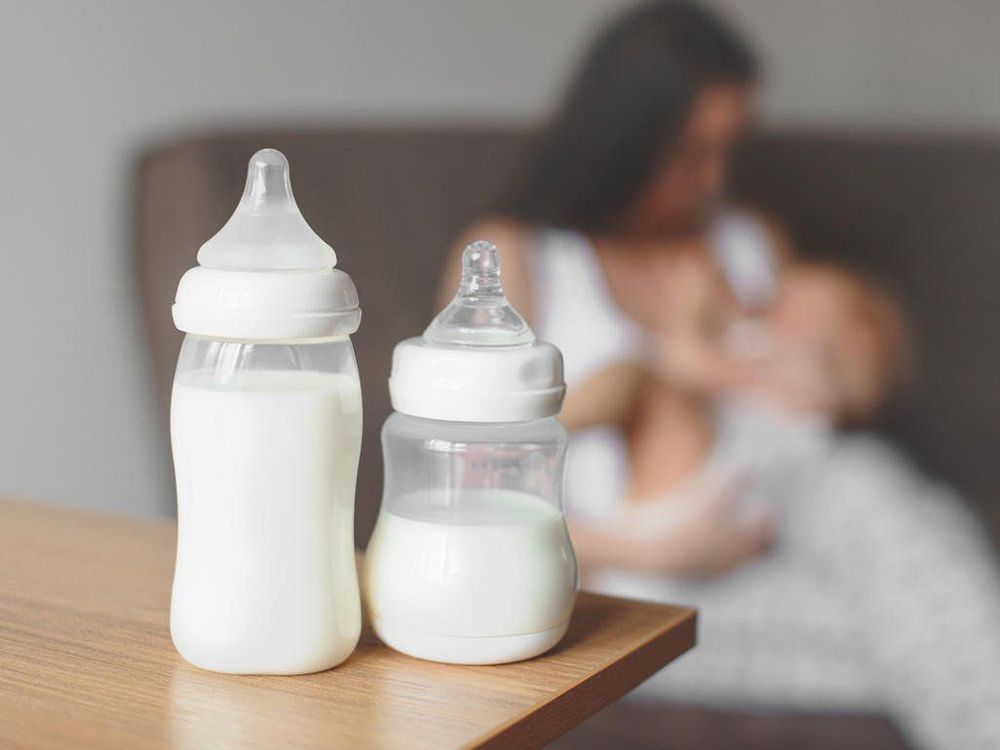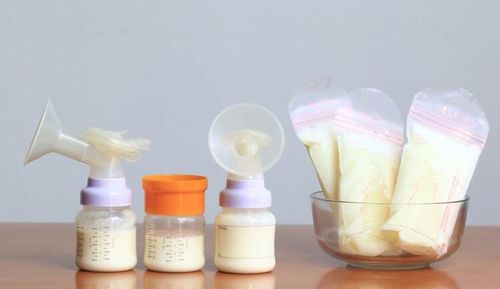This is an automatically translated article.
The article was professionally consulted with resident Doctor Ho Thi Hong Tho - Neonatologist - Department of Pediatrics - Neonatology - Vinmec Phu Quoc International General Hospital.Breastfeeding is a very common thing that happens to women who are breastfeeding with the purpose of storing milk for the baby to suckle when the mother is not around and stimulating the mother's milk supply.
1. Why is breast milk necessary?
The most common reasons for pumping are so that the baby can have milk when the mother is not around and to maintain the mother's milk supply. This is also important if you are going back to work but still want your baby to continue to drink breast milk. If that's the case with you, it's a good idea to practice pumping for a few weeks before you start feeding your baby with reserve breast milk. Just make sure that breastfeeding is well established before you give your baby a bottle.Pumping is also for the following reasons:
To stimulate milk production and increase milk production. Having to get milk to feed a premature baby or a baby who is unable to latch on To relieve the pain and pressure of the breasts during engorgement, although pumping too much when you are engorged can make matters worse To maintain milk supply if the mother has to temporarily stop breastfeeding because she is taking medication that could harm her baby or because she has to be hospitalized for a short time and cannot breastfeed throughout the day. Most women express milk with an electric pump or by hand. Some women prefer to express milk by hand, but most find using a breast pump quicker and easier. While it may feel strange to use a breast pump at first, it usually doesn't take long for it to be quick and easy.
To use an electric pump, place a breast pump (or shield) on your nipple, turn it on, and place the pump in the included carrying case. Manual vacuums work by operating the squeegee or manually pulling the pistons instead of relying on the motor. It usually takes ten to 15 minutes to express both breasts with a good electric machine and up to 45 minutes with a manual machine. A good breast pump will mimic a newborn's sucking action and won't hurt you. Make sure you use the correct size for your nipples and place them just right so you don't get pinched or uncomfortable.
Consider buying a bra so you don't have to keep the machines on your breasts. That way, your hands can be free while pumping. Some moms make their own pump bras by attaching rubber bands to the clasps of regular nursing bras or by punching holes in old jogging bras.
Remember that for pain relief and best milk production, you need to be calm and relaxed. It will be difficult at first, but it may feel a bit odd. Remember to carefully clean the pump parts after each pumping session.

2. What type of breast pump should I use?
Choosing the right breast pump for you depends on how often you use it and how much time you can spend pumping. If you work full-time and have to find time to pump during a busy workday, you'll want to use a fully automatic pump that can quickly pump both breasts at once. But if you only need to pump a few dozen milliliters of milk every now and then, an inexpensive manual pump can work just fine.If you only need to express milk occasionally, for example in the rare case of bottle feeding, you can express milk by hand. Expressing some breast milk by hand can help ease engorgement and blocked milk ducts. If you have sore, cracked nipples, you may want to express some breast milk by hand after each feeding, then you can gently massage your breasts to help soothe your sore and engorged breasts.
However, many women find that expressing milk by hand is time consuming, so it is often not feasible if you need to express larger amounts of milk frequently. Here are the steps to perform milking
Wash your hands before starting. A little breast massage or a warm towel before expressing milk Sit and lean forward Place thumb and index finger on each side of the breast, about 3cm behind the areola, forming the letter C with the hand Press the fingers toward the chest wall and gently touch each other. Use a rolling motion rather than pulling or tugging Rotate your fingers around the areola (eg starting from top to bottom and moving to the sides) as you continue expressing breast milk from each breast Take milk into any carton Who has a wide mouth?

3. How to store breast milk?
You can store breast milk in a nursing bottle or a plastic or glass storage container. The safety lid will keep the milk fresh. You can also use special plastic bags for milk. Fill the container three-quarters full if it is in the freezer. For convenience, store breast milk in the amount you would normally use while breastfeeding. If your baby normally drinks 40-50ml of milk, then stock up in 40-50ml portions. Be sure to date the bottles or bags before you put them in the fridge or freezer so you'll know when you've started storing them. Do not combine fresh milk and frozen milk.It is normal for breast milk to have fat separating and floating on top and sometimes a bluish color, especially in the early stages. Milk color can be affected by your diet or medications. Do not shake the milk, instead, gently swirl it to mix the fat back in.
Breast milk should not smell or taste sour, but after thawing it sometimes has a mild soapy smell due to the change in fat. This is perfectly fine. Freezing destroys some of the antibodies in the milk, so don't freeze it unless you have to. But frozen breast milk is still healthier and more protective from disease than formula.
4. How long can breast milk be stored?
There are different opinions about how long breast milk stays fresh after it leaves the body. The Centers for Disease Control and Prevention (CDC) says milk can be kept at room temperature for 6 to 8 hours, but it's best to refrigerate it immediately after pumping. Use fresh milk in the refrigerator within five days.Frozen breast milk must be stored in the freezer compartment of the refrigerator (5 degrees F or about -15 degrees C), it can be frozen for two weeks. If there is a freezer with its own door (0 degrees F or -18 degrees C), it can be stored for three to six months. In the deep freezer (-4 degrees F or -20 degrees C), milk stays good for six to 12 months.
Once frozen milk has been defrosted, you can keep it in the refrigerator for up to 24 hours. If it's at room temperature, use it within an hour. If you do not use it within that time, you must throw it away because you cannot refreeze it. If you need to transport milk, keep it refrigerated until just before using.
To defrost frozen milk, hold the bag or bottle under warm running water until the appropriate temperature, or leave the defrosted milk in the refrigerator overnight. Do not use the microwave to defrost or reheat as it kills the nutrients in breast milk.

5. What to do if you have trouble pumping milk?
For many women, the hardest thing is finding a pump time that fits into the workday schedule or finding a comfortable, private space to do it. But pumping isn't easy for everyone. Here are some reasons why you might be having trouble with your milk supply and some tips to deal with it:You may pump too early so you won't get as much milk out of your breasts. Don't stress about pinpointing the right time to pump, but keep this in mind if you find that you're not producing much milk. You may need to change the settings on the pump. It can be difficult to get enough milk if the suction pressure is too low or the speed is too fast. In some cases, the pump may not provide the right pump model for you no matter how you adjust it. Today's most advanced pumps come with a reprogrammable setting card that you can send back to the manufacturer for adjustment. Some women have trouble getting enough milk if they're using a manual pump or an electric pump that doesn't work well (after about a year of use, the battery can wear out). You will get the best results from a high quality double electric pump. You may be using a shield (phalanges) that is too small for the nipple. This is a common problem as most pumps that come with phalanges are designed for women with small nipples. If your nipples are too small and your nipples swell when you start pumping, you won't be able to get as much milk out of your breasts. Many breast pump companies now produce pumps in larger sizes. Make sure you're using the right size for you. You may not produce much milk. There are many reasons for this, including not regularly breastfeeding and not getting enough water by drinking lots of water. Certain medications, like decongestants or estrogens, can also suppress milk supply. You may have trouble with milk coming down. Try to relax and feel comfortable while pumping. You can also try gently massaging your breasts or applying heat to them before pumping.
Children in the period from 6 months to 3 years old are very susceptible to respiratory problems, respiratory infections, skin diseases and gastrointestinal infections... parents need special attention attention to the care and provision of adequate nutrition for children.
Children who do not eat properly are at risk of micro-mineral deficiency causing anorexia, growth retardation, malabsorption,... If they notice the above signs, parents should supplement their children with products. The supplement contains lysine, essential micro-minerals and vitamins such as zinc, chromium, selenium, and B vitamins to help fully meet the nutritional needs of children. At the same time, these essential vitamins also support digestion, enhance nutrient absorption, help improve anorexia, and help children eat well.
Parents can learn more:
Signs of zinc deficiency in children
Micronutrient deficiency and failure to gain weight in children
Please regularly visit Vinmec.com website and update useful information to take care of your child. Take care of the baby and the whole family.
Please dial HOTLINE for more information or register for an appointment HERE. Download MyVinmec app to make appointments faster and to manage your bookings easily.
Reference source: babycenter.com













